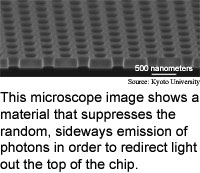
Crystal promises more light
Chip-based devices that emit or absorb
light, like light-emitting diodes, are relatively inexpensive and increasingly
efficient, but they are limited by spontaneous emission -- the tendency
to uncontrollably fire off photons in all directions.
Spontaneous emission lowers the efficiency of devices designed
to control light and also produces noise that can interfere with signals
to make the devices less precise.
Researchers from Kyoto University have demonstrated a device that
inhibits spontaneous emission by redirecting the energy to a useful purpose.
The method could lead to more efficient light-emitting diodes, lasers,
displays, solar cells, and quantum-information systems.
The researchers' device is a 5-nanometer-wide light-emitting bit
of semiconductor material embedded in a two-dimensional photonic crystal.
Photonic crystal is a material that contains regularly-spaced holes that
block light. The size of the holes controls the range of wavelengths that
can travel through the crystal.
Most photonic crystal devices contain areas without holes that
channel light. The researchers' crystal has holes throughout. The researchers
made different crystals with holes ranging from 174 to 290 nanometers
and spaced 300 to 500 nanometers center-to-center. A nanometer is one
millionth of a millimeter.
The material blocked five times as much spontaneously-emitted
light in the plane of the crystal and emitted five times as much light
from the surface of the device as non-photonic-crystal chips, according
to the researchers.
The method has the potential to dramatically increase the efficiency
of increasingly popular light-emitting diode lights, according to the
researchers. The work could be used practically in three to five years,
according to the researchers.
The work appeared in the May 27, 2005 issue of Science
(Simultaneous Inhibition and Redistribution of Spontaneous Light Emission
in Photonic Crystals). -TECHNOLOGY RESEARCH NEWS
Stories:
Nanowire networks route light
Cell combo yields blood vessels
Physics maps city complexity
How It Works: Self-assembly
Briefs:
Paint program renders ink physics
Silicon light switch is electric
Crystal promises more light
Micro marbles make nano rings

Research Watch blog
View from the High Ground Q&A
How It Works
RSS Feeds:
News
Ad links:
Buy an ad link
Ad links: Clear History
Buy an ad link
|
TRN
Newswire and Headline Feeds for Web sites
|
© Copyright Technology Research News, LLC 2000-2010. All rights reserved.